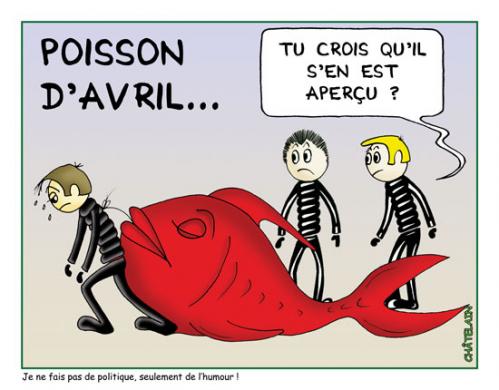For centuries, April 1 has been a day marked by hoaxes and practical jokes played on people around the world. From large pranks about spaghetti trees in Switzerland or the tower of Pisa falling over, to small practical jokes played on friends and family members at home, April 1 has long been a day when people try to fool and are fooled by others.
France is no exception to this world-wide tradition, and in fact many people think April Fools’ Day originated in France.

French Origins of April Fools Day
Although the origins of April Fools is obscure and debated, the most widely accepted explanation actually credits the “holiday” as starting in France. The most popular theory about the origin of April Fool’s Day involves the French calendar reform of the sixteenth century.

The theory goes like this: In 1564 King Charles XIV of France reformed the calendar, moving the start of the year from the end of March to January 1. However, in a time without trains, a reliable post system or the internet, news often traveled slow and the uneducated, lower class people in rural France were the last to hear of and accept the new calendar. Those who failed to keep up with the change or who stubbornly clung to the old calendar system and continued to celebrate the New Year during the week that fell between March 25th and April 1st, had jokes played on them. Pranksters would surreptitiously stick paper fish to their backs. The victims of this prank were thus called Poisson d’Avril, or April Fish—which, to this day, remains the French term for April Fools—and so the tradition was born.
Poisson d’Avril
 Today in France, those who are fooled on April 1 are called the “Poisson d’Avril” (the April Fish). A common prank (especially among school-aged children) is to place a paper fish on the back of an unsuspecting person. When the paper fish is discovered, the victim is declared a “Poisson d’Avril.”
Today in France, those who are fooled on April 1 are called the “Poisson d’Avril” (the April Fish). A common prank (especially among school-aged children) is to place a paper fish on the back of an unsuspecting person. When the paper fish is discovered, the victim is declared a “Poisson d’Avril.”
While it is not clear of the origins of fish being associated with April 1, many think the correlation is related to zodiac sign of Pisces (a fish), which falls near April.
If you are looking for an easy way to prank your friends or family, doodling or cutting out a paper fish and sticking it on the back of an unsuspecting victim is an easy (though admittedly juvenile) way of commemorating the origins of April Fools’ Day.
Of course as someone who enjoys France in large part because of all the amazing food, my personal favorite part about Poisson d’Avril are the plethora of bakeries and cholocatiers that make fish shaped French pastries and chocolates in honor of the holiday. Carol Gillot, who writes the blog Paris Breakfasts, has a great collection of such fish-shaped treats on her blog.
While the poisson d’Avril may have originated in France, it is certainly not the only country where April Fools’ Day is celebrated with paper fish. In fact, Italy’s Version of April Fools’ Day is very similar to the French one (and was probably adopted from their neighbors to the north).
วิธีการเล่นในวัน April Fool's Day คือ... วันที่ 1 เมษายน ซึ่งเป็นวัน April's Fool Day เป็นวันที่คนแกล้งหลอกกันด้วยการแต่งเรื่องอะไรก็ได้มาหลอกให้คนอื่นหลงเชื่อ จากนั้นค่อยเฉลยในตอนท้าย ซึ่งเรื่องที่เอามาหลอกนั้นจะต้องไม่ทำให้อีกฝ่ายถึงกับเลือดตกยางออก และคนที่ถูกหลอกจะต้องไม่โกรธด้วย เพราะถือว่าวันนี้เป็นวันพิเศษ ยกเว้นให้หนึ่งวัน
ประวัติความเป็นมา วันโกหก April Fool's Day
มีตำนานเล่ากันมาว่า เมื่อสมัยก่อน พวกฝรั่งเขาก็มีวันขึ้นปีใหม่ใกล้ ๆ บ้านเรานี่แหละ คือเดือนเมษายน แต่แล้วทางการมีการเปลี่ยนวันปีใหม่เป็นวันที่ 1 มกราคม บังเอิญยังมีอีกหลายคนที่ไม่รู้ ก็ยังคงส่ง ส.ค.ส. ให้กันในวันที่ 1 เมษายน พวกเขาก็เลยเรียกพวกนี้ว่าพวก "เมษาหน้าโง่" แล้วก็มีการแกล้งกันโดยไม่บอกความจริงเพื่อความสนุกสนาน จนกลายเป็นเทศกาลที่รู้จักและเล่นกันในหลายประเทศทั่วโลก ไม่ว่าจะเป็น สหรัฐอเมริกา อังกฤษ ฝรั่งเศส สกอตแลนด์ อิตาลี สเปน โปรตุเกส สวีเดน เยอรมนี นอร์เวย์ ญี่ปุ่น ฯลฯ โดยแต่ละประเทศอาจมีวันโกหก ไม่ตรงกับวันที่ 1 เมษายน เสมอไป อย่างไรก็ตาม มีหลายทฤษฎีเกี่ยวกับความเป็นมาของวันโกหก April Fool's Day บ้างก็ระบุว่า เริ่มจากพวกโรมันโบราณ มีเทศกาลที่เรียกว่า "Cerealia" จัดในช่วงต้นเดือนเมษายน เรื่องเล่านี้มีว่า เทพเจ้าชื่อ Ceres ทรงได้ยินเสียงสะท้อนของพระธิดา Prosperpina ตะโกนมาว่า เธอถูกจับตัวไปอยู่ใต้ผืนดินโดยเทพพลูโต Ceres จึงตามเสียงลูกสาวไป และได้พบความจริงที่ว่า การตามเสียงสะท้อนเป็นเรื่องที่ไม่ฉลาดเลย เหมือนว่าพระองค์ทรงถูกหลอกนั่นเอง
นอกจากนี้ ยังมีอีกทฤษฎีที่เชื่อว่า วันโกหก April Fool's Day เกิดจากช่วงฤดูใบไม้ผลิ ที่เล่าสืบต่อกันมาว่า ในช่วงฤดูใบไม้ผลิ หนุ่มสาวจะออกตามหาความรัก และเป็นช่วงที่พืชเจริญเติบโต ในขณะที่สัตว์ต่าง ๆ ก็หาคู่ด้วย กลุ่มนักบวชจึงพยายามหลอกล่อวิญญาณของความชั่วร้ายอย่างสุดความสามารถ เพื่อไม่ให้มาขัดขวางความรักของทั้งหนุ่มสาว พืช และสัตว์ ดังนั้น จึงเป็นเดือนที่นักบวชจะต้องสวดเพื่อหลอกเหล่าวิญญาณร้ายนั่นเอง





